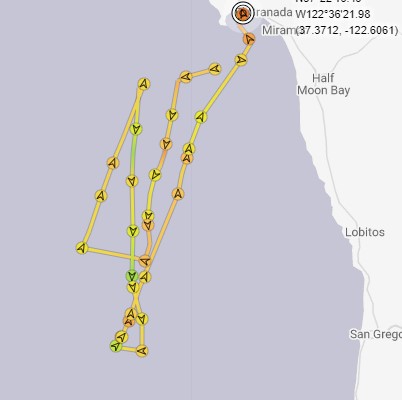I think it’s time to take stock and see where I am. Have odds improved? Let’s start with time.
Time constraints
As indicated elsewhere timing calls for a departure mid October, which assumes an average boat speed of 7 kts. Granted Changabang is a fast boat and even a bump to a 7.5 kts average speed would allow us to depart 3 weeks later. So, there’s a bit of wiggle room with the start date.
Regardless, I am considering allowing one month for final preparation and loading. Before that Changabang will get a new bottom paint in the boatyard, for which I’m generously allocating one month too. That means that we need to be ready by mid August. Considering we’re about mid June, that leaves me with two months. I feel good that, based on what I plan to do, I will be able to leave this year.
What is left to do?
In the order of importance, I see the following: a safe passage making sailing vessel, a strong electrical system, redundancy in self-steering and navigation means. The rest I see as gravy.
A safe sailing vessel
From what I have been able to identify and experience, Changabang is doing solid in this category. The remaining weaknesses are: a (slow) leaking internal ballast system (it’s never good to have a leak in a boat); a keel bolt and damage that would benefit from further investigation. These two items can only be addressed when the boat will be out of the water, which is why I am allowing one month for the one week bottom paint job.
The running rigging is a bit of a weak point. I am not going to address it before leaving. My plan for now is to buy a spool of excellent line and replace as necessary.
What makes a sailing vessel safe is the ability of the skipper to handle the boat in all conditions. I am not going to be able to experiment in all the sailing conditions I will encounter. So this will be a weak point of my preparation, with hopefully strong improvements as I learn during the first few thousand miles.
A strong electrical system
Electricity generation will be left to Watt & Sea hydrogenerators, one to port and one to starboard. I’ll have a spare generator and about 4 propellers. I hope these will last the whole trip. The installation is not complete yet but should be in a couple of weeks. Testing after that, during a shake down cruise, will reveal if all is good.
Electricity is stored in 3 lead acid batteries. In a perfect world, I would have them tested for health, and I may still do that. But replacing them is unlikely What I will do though is purchase an additional battery. If those I have fail then I’ll swap them out.
I also have 275W of solar panels and a diesel engine with a 115A alternator. I’ll leave with about 80 liters of diesel, which would be good for about 20 hours of charging.
In conclusion, we’re almost ready here, unless the hydrogenerators fail the real life test.
Self-steering
Sadly I just discovered a major weakness in one of the two auto-pilots. They require a rudder angle sensor. The installers in France did something fairly stupid: they installed a non waterproof sensor outside! So I need to replace that, which will cost me about $600+. And I’d do well to have a backup but I don’t think I’ll spend that money.
I will try to get a used Lecomble & Schmitt auto-pilot for parts as well. I do need to replace the hydraulic oil in these two systems. The secondary system is old.
I plan to install an above deck autopilot too. So, all in all, the situation here is not too bad. With a spare rudder angle sensor it would significantly improve though.
Navigation
I do think that I have addressed this fairly well several months ago. So I’ll consider this as 90% complete.
Conclusion
I feel like a departure this year is still highly possible.












